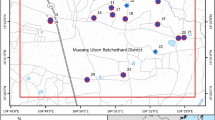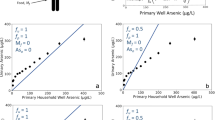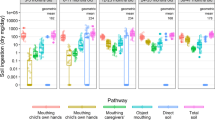Abstract
A cross sectional study using environmental and biological samples was undertaken to assess the association between arsenic (As) soil concentrations and urinary As levels of children living in an area where the soil is naturally As rich, during summer and winter. Twenty-nine children aged between 2 and 7 years from 21 dwellings in the summer study, and 23 of the 29 previous children from 17 dwellings in the winter study, were recruited. Housing characteristics, living conditions and individual characteristics were collected by questionnaire, and urine samples were collected for iAs+MMA+DMA measurement. Soil total As content and bioaccessibility were measured. Urinary As concentrations revealed that the children were not overexposed. Low bioaccessibility combined with moderately high levels in soil could explain this result. The concentration of arsenic in soil and soil-related factors appeared to contribute to the children's impregnation in summer but not in winter, which could be related to the children's behavior. This study highlights the need for additional studies of children to better understand their behavior, and obtain reference values in this particular population.
This is a preview of subscription content, access via your institution
Access options
Subscribe to this journal
Receive 6 print issues and online access
$259.00 per year
only $43.17 per issue
Buy this article
- Purchase on Springer Link
- Instant access to full article PDF
Prices may be subject to local taxes which are calculated during checkout
Similar content being viewed by others
References
U.S. Agency for Toxic Substances and Disease Registry (US ATSDR). Toxicological Profile for Arsenic. U.S. Agency for Toxic Substances and Disease Registry (US ATSDR), Atlanta, GA, 2007. Available at http://www.atsdr.cdc.gov/toxprofiles/tp2.pdf.
Wang S.L., Chiou J.M., Chen C.J., Tseng C.H., Chou W.L., Wang C.C., Wu T.N., and Chang L.W. Prevalence of non-insulin-dependent diabetes mellitus and related vascular diseases in southwestern arseniasis-endemic and nonendemic areas in Taiwan. Environ Health Perspect 2003: 111: 155–159.
Wang C.H., Hsiao C.K., Chen C.L., Hsu L.I., Chiou H.Y., Chen S.Y., Hsueh Y.M., Wu M.M., and Chen C.J. A review of the epidemiologic literature on the role of environmental arsenic exposure and cardiovascular diseases. Toxicol Appl Pharmacol 2007: 222: 315–326.
IARC Working Group on the Evaluation of Carcinogenic Risks to Humans. Some Drinking-Water Disinfectants and Contaminants, Including Arsenic: IARC Working Group on the Evaluation of Carcinogenic Risks to Humans. IARC Press, Lyon, France, 2004: Vol. 84.
Yoshida T., Yamauchi H., and Fan S.G. Chronic health effects in people exposed to arsenic via the drinking water: dose-response relationships in review. Toxicol Appl Pharmacol 2004: 198: 243–252.
Smedley P.L., and Kinniburgh D.G. A review of the source behaviour and distribution of arsenic in natural waters. Appl Geochem 2002: 17: 517–568.
Bhattacharya P., Welch A.H., Stollenwerk K.G., McLaughlin M.J., Bundschuh J., and Panaullah G. Arsenic in the environment: biology and chemistry. Sci Total Environ 2007: 379: 109–120.
Caussy D. Case studies of the impact of understanding bioavailability: arsenic. Ecotoxicol Environ Saf 2003: 56: 164–173.
Fillol C., Dor F., Clozel B., Goria S., and Seta N. Does arsenic in soil contribute to arsenic urinary concentrations in a French population living in a naturally arsenic contaminated area? Sci Total Environ 2010a: 408: 6011–6016.
Weaver V.M., Buckley T.J., and Groopman J.D. Approaches to environmental exposure assessment in children. Environ Health Perspect 1998: 106 (Suppl 3): 827–832.
Moya J., Bearer C.F., and Etzel R.A. Children's behavior and physiology and how it affects exposure to environmental contaminants. Pediatrics 2004: 113: 996–1006.
Thompson K.M. Changes in children's exposure as a function of age and the relevance of age definitions for exposure and health risk assessment. Med Gen Med 2004: 6: 2.
Xue J., Zartarian V., Moya J., Freeman N., Beamer P., Black K., Tulve N., and Shalat Z. A meta-analysis of children's hand-to-mouth frequency data for estimating nondietary ingestion exposure. Risk Anal 2007: 27 (2): 411–420.
Stanek E.J., Calabrese E.J., and Zorn M. Biasing factors for simple soil ingestion estimates in mass balance studies of soil ingestion. Hum Ecol Risk Assessment 2001: 7: 329–355.
Fillol C., Dor F., Labat L., Boltz P., Le B.J., Mantey K., Mannschott C., Puskarczyk E., Viller F., Momas I., and Seta N. Urinary arsenic concentrations and speciation in residents living in an area with naturally contaminated soils. Sci Total Environ 2010b: 408: 1190–1194.
Cave M., Wragg J., Klinck B., Gron C., Oomen T.,, van de Wiele T ., et al. Preliminary assessment of a unified bioaccessibility method for potentially harmful elements in soils. Epidemiology 2006: 17: S39.
Hwang Y.H., Bornschein R.L., Grote J., Menrath W., and Roda S. Environmental arsenic exposure of children around a former copper smelter site. Environ Res 1997a: 72: 72–81.
Tsuji J.S., Van K., Kaetzel R.S., Scrafford C.G., Mink P.J., Barraj L.M., Crecelius E.A., and Goodman M. Evaluation of exposure to arsenic in residential soil. Environ Health Perspect 2005: 113: 1735–1740.
Link B., Gabrio T., Piechotowski I., Zollner I., and Schwenk M. Baden-Wuerttemberg Environmental Health Survey (BW-EHS) from 1996 to 2003: toxic metals in blood and urine of children. Int J Hyg Environ Health 2007: 210: 357–371.
Seifert B., Becker K., Helm D., Krause C., Schulz C., and Seiwert M. The German Environmental Survey 1990/1992 (GerES II): reference concentrations of selected environmental pollutants in blood, urine, hair, house dust, drinking water and indoor air. J Expo Anal Environ Epidemiol 2000: 10: 552–565.
Wilhelm M., Schulz C., and Schwenk M. Revised and new reference values for arsenic, cadmium, lead, and mercury in blood or urine of children: basis for validation of human biomonitoring data in environmental medicine. Int J Hyg Environ Health 2006: 209: 301–305.
Schulz C., Conrad A., Becker K., Kolossa-Gehring M., Seiwert M., and Seifert B. Twenty years of the German Environmental Survey (GerES): human biomonitoring — temporal and spatial (West Germany/East Germany) differences in population exposure. Int J Hyg Environ Health 2007: 210: 271–297.
Becker K., Müssig-Zufika M., Conrad A., Lüdecke A., Schulz C., Seiwert M., and Kolossa-Gehring M. German Environmental Survey for Children 2003/06 –GerES IV- Human biomonitoring levels of selected substances in blood and urine of children in Germany, WaBoLu-Hefte 01/08, ISSN 1862-4340 Federal Environment Agency, Dessau-Roßlau. Available at http://www.umweltbundesamt.de/uba-info-medien-e/3355.html, 2008.
Hinwood A.L., Sim M.R., Jolley D., de K.N., Bastone E.B., Gerostamoulos J., and Drummer O.H. Exposure to inorganic arsenic in soil increases urinary inorganic arsenic concentrations of residents living in old mining areas. Environ Geochem Health 2004: 26: 27–36.
Hartwell T.D., Handy R.W., Harris B.S., Williams S.R., and Gehlbach S.H. Heavy metal exposure in populations living around zinc and copper smelters. Arch Environ Health 1983: 38: 284–295.
Ranft U., Miskovic P., Pesch B., Jakubis P., Fabianova E., Keegan T., Hergemoller A., Jakubis M., and Nieuwenhuijsen M.J. Association between arsenic exposure from a coal-burning power plant and urinary arsenic concentrations in Prievidza District, Slovakia. Environ Health Perspect 2003: 111: 889–894.
Hysong T.A., Burgess J.L., Cebrian Garcia M.E., and O’Rourke M.K. House dust and inorganic urinary arsenic in two Arizona mining towns. J Expo Anal Environ Epidemiol 2003: 13: 211–218.
Hwang Y.H., Bornschein R.L., Grote J., Menrath W., and Roda S. Urinary arsenic excretion as a biomarker of arsenic exposure in children. Arch Environ Health 1997b: 52: 139–147.
Clayton C.A., Pellizzari E.D., Whitmore R.W., Perritt R.L., and Quackenboss J.J. National Human Exposure Assessment Survey (NHEXAS): distributions and associations of lead, arsenic and volatile organic compounds in EPA region 5. J Expo Anal Environ Epidemiol 1999: 9: 381–392.
Pellizzari E.D., and Clayton C.A. Assessing the measurement precision of various arsenic forms and arsenic exposure in the National Human Exposure Assessment Survey (NHEXAS). Environ Health Perspect 2006: 114: 220–227.
Freeman G.B., Johnson J.D., Killinger J.M., Liao S.C., Davis A.O., Ruby M.V., Chaney R.L., Lovre S.C., and Bergstrom P.D. Bioavailability of arsenic in soil impacted by smelter activities following oral administration in rabbits. Fundam Appl Toxicol 1993: 21: 83–88.
Freeman G.B., Schoof R.A., Ruby M.V., Davis A.O., Dill J.A., Liao S.C., Lapin C.A., and Bergstrom P.D. Bioavailability of arsenic in soil and house dust impacted by smelter activities following oral administration in cynomolgus monkeys. Fundam Appl Toxicol 1995: 28: 215–222.
Carrizales L., Razo I., Tellez-Hernandez J.I., Torres-Nerio R., Torres A., Batres L.E., Cubillas A.C., and az-Barriga F. Exposure to arsenic and lead of children living near a copper-smelter in San Luis Potosi, Mexico: importance of soil contamination for exposure of children. Environ Res 2006: 101: 1–10.
Rieuwerts J.S., Searle P., and Buck R. Bioaccessible arsenic in the home environment in southwest England. Sci Total Environ 2006: 371: 89–98.
Palumbo-Roe B., and Klinck B. Bioaccessibility of arsenic in mine waste-contaminated soils: a case study from an abandoned arsenic mine in SW England (UK). J Environ Sci Health A Tox Hazard Subst Environ Eng 2007: 42: 1251–1261.
Roberts S.M., Munson J.W., Lowney Y.W., and Ruby M.V. Relative oral bioavailability of arsenic from contaminated soils measured in the cynomolgus monkey. Toxicol Sci 2007: 95: 281–288.
Ruby M.V., Davis A., Schoof R., Eberle S., and Sellstone C.M. Estimation of pb and As bioavailability using a physiologically based extraction test. Environ Sci Technol 1996: 30: 422–430.
Ono F.B., Guilherme L.R., Penido E.S., Carvalho G.S., Hale B., Toujaguez R., and Bundschuh J. Arsenic bioaccessibility in a gold mining area: a health risk assessment for children. Environ Geochem Health 2011; e-pub ahead of print.
Polissar L., Lowry-Coble K., Kalman D.A., Hughes J.P., van B.G., Covert D.S., Burbacher T.M., Bolgiano D., and Mottet N.K. Pathways of human exposure to arsenic in a community surrounding a copper smelter. Environ Res 1990: 53: 29–47.
Gebel T.W., Suchenwirth R.H., Bolten C., and Dunkelberg H.H. Human biomonitoring of arsenic and antimony in case of an elevated geogenic exposure. Environ Health Perspect 1998: 106: 33–39.
Calderon R.L., Hudgens E., Le X.C., Schreinemachers D., and Thomas D.J. Excretion of arsenic in urine as a function of exposure to arsenic in drinking water. Environ Health Perspect 1999: 107: 663–667.
Concha G., Vogler G., Nermell B., and Vahter M. Intra-individual variation in the metabolism of inorganic arsenic. Int Arch Occup Environ Health 2002: 75: 576–580.
Acknowledgements
This study was supported by a grant of the Agence de l’Environnement et de la maîtrise de l’Energie, Ademe (French Environment and Energy Management Agency) and the Institut de veille sanitaire, InVS (French Institute for Public Health Surveillance). We are grateful to the interviewers in Nancy (Centre d’épidémiologie Clinique, CEC), the Cire-Est (Cellule de l’Institut de veille sanitaire en région), the DDASS 54 (Direction Départementale des Affaires Sanitaires et Sociales), the DRASS of Lorraine (Direction Régionale des Affaires Sanitaires et Sociales), the local air pollution-monitoring network (AIRLOR), and Claire Dassonville. We would like to thank all the subjects who participated in this study.
Author information
Authors and Affiliations
Corresponding author
Ethics declarations
Competing interests
The authors declare no conflict of interest.
Rights and permissions
About this article
Cite this article
Fillol, C., Dor, F., Denys, S. et al. Arsenic urinary concentrations in children living in a naturally arsenic contaminated area. J Expo Sci Environ Epidemiol 23, 145–150 (2013). https://doi.org/10.1038/jes.2012.72
Received:
Accepted:
Published:
Issue Date:
DOI: https://doi.org/10.1038/jes.2012.72
Keywords
This article is cited by
-
Contamination assessment and health risk of arsenic exposure to stairway dust in the zinc smelting district, Northeast China
Environmental Geochemistry and Health (2019)



